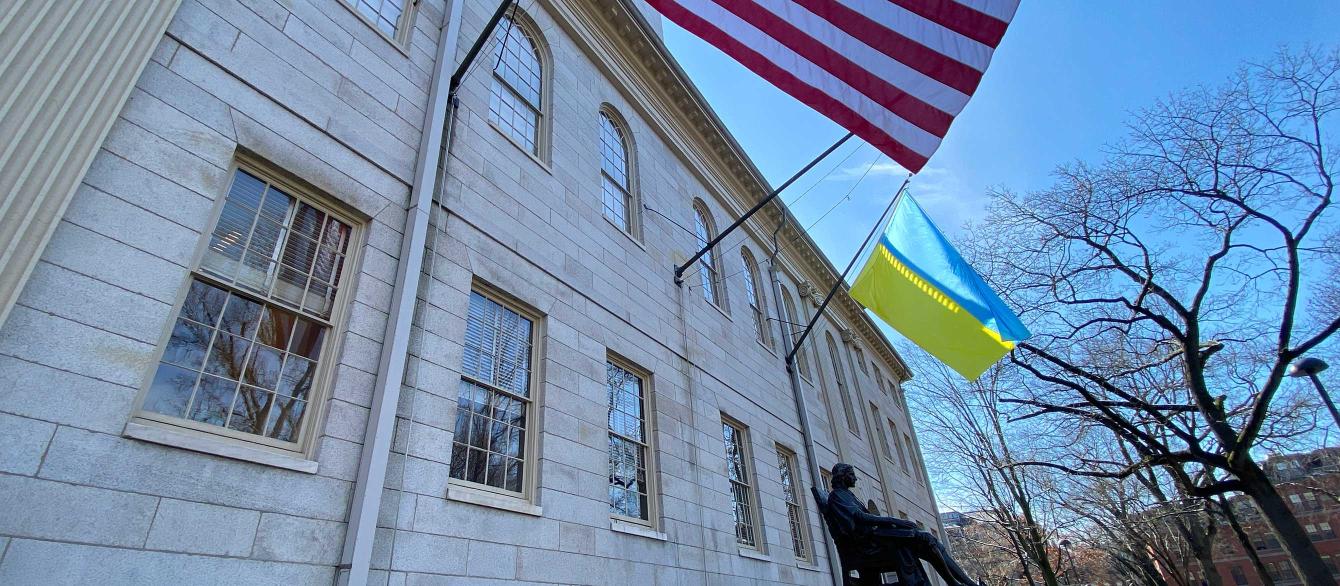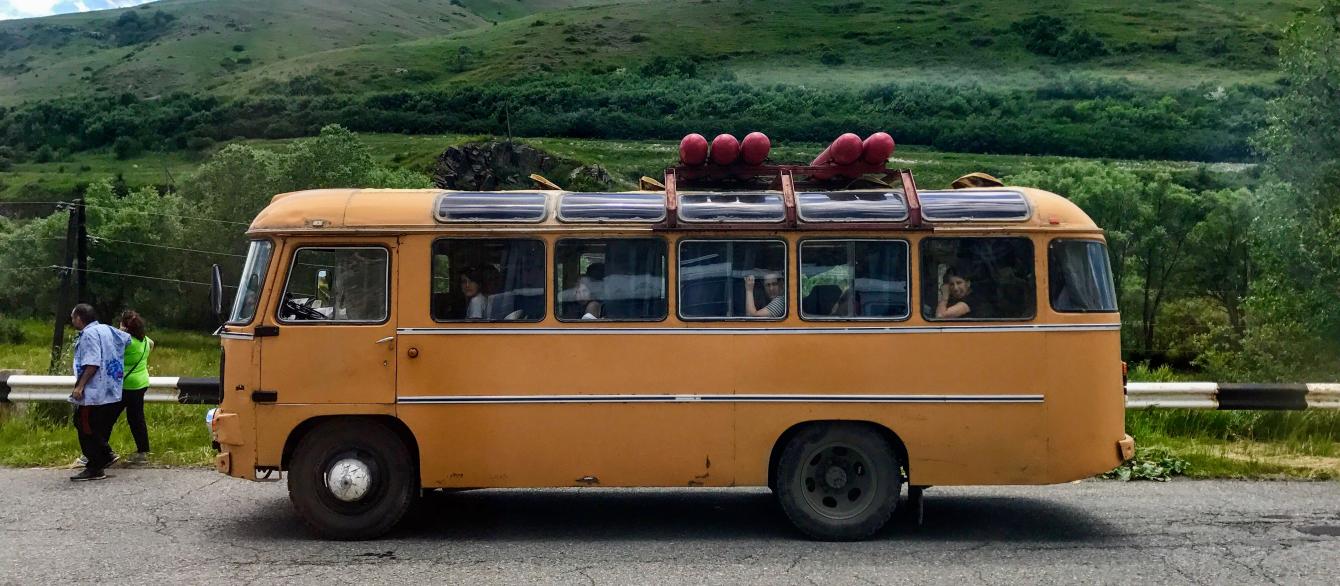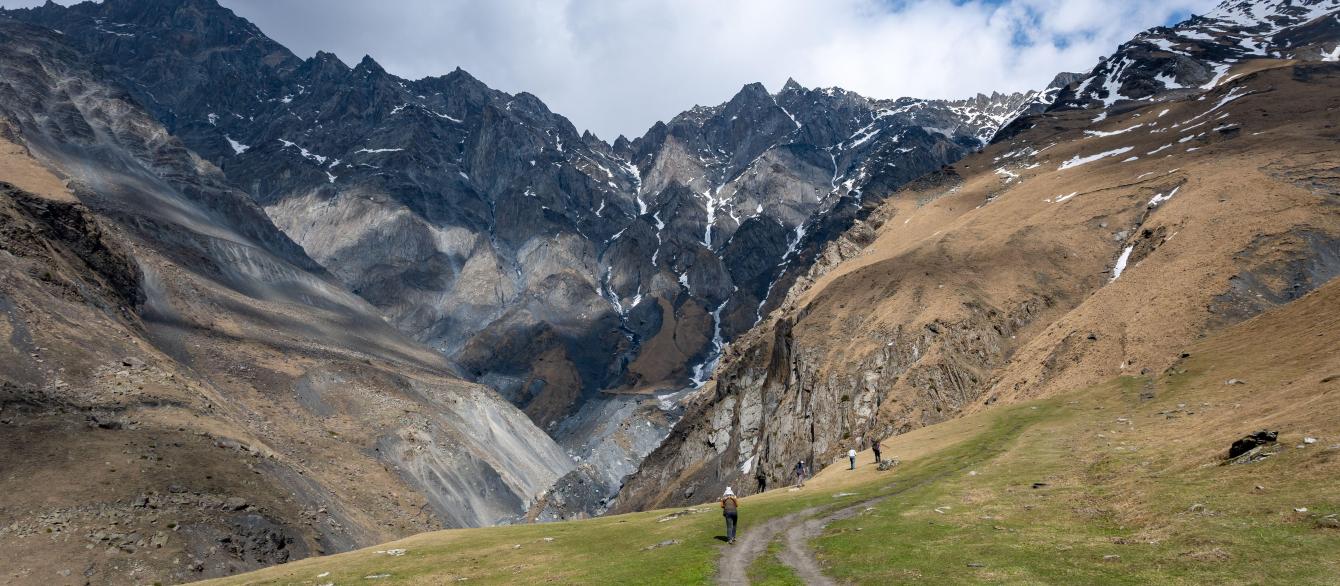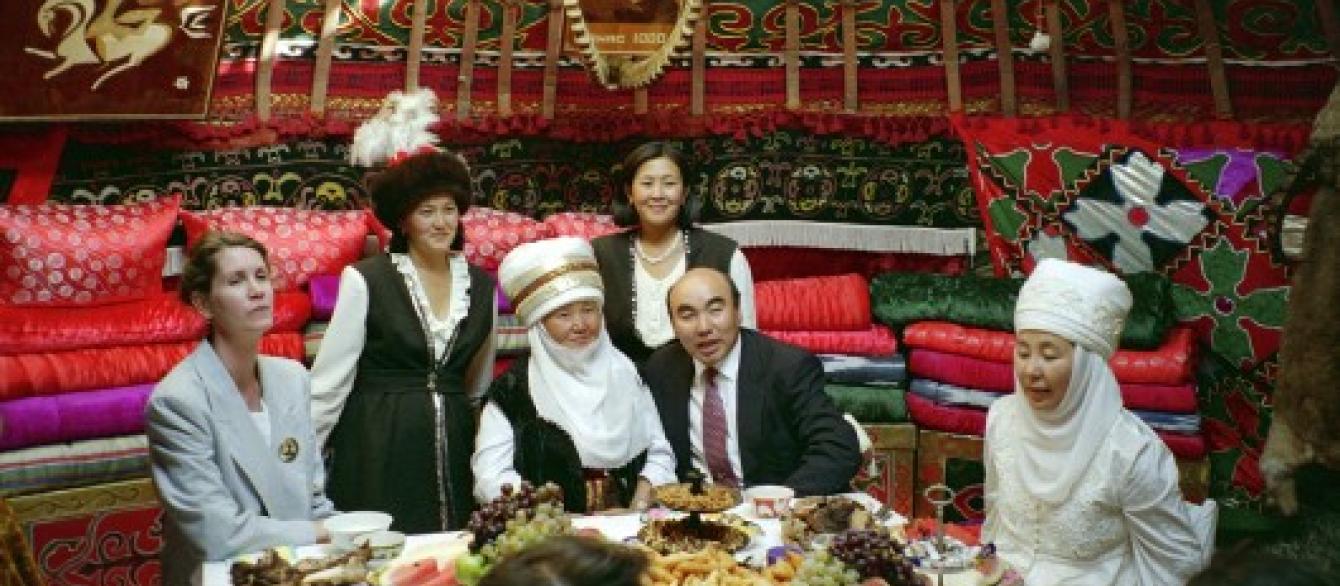This essay was originally published by Eurasianet.org as part of a series initiated and coordinated by Dr. Nagis Kassenova, director of our Program on Central Asia, in which retired U.S. diplomats share their experiences of working in the region during its early years of post-Soviet independence.
The question I was asked most frequently during my time as U.S. Ambassador to Kyrgyzstan from 1994 to 1997 was why the United States government was investing so much of our limited assistance funds on a double landlocked country tucked in behind Russia, China, and Afghanistan. The simple answer was that it was in our national security interest to help the newly independent countries emerging from the USSR make a peaceful transition to sovereign states.
The violent splintering of Yugoslavia, with the ethnic cleansing that followed, made clear the imperative to avoid anything similar taking place in Central Asia. Once that decision had been made, each of the U.S. embassies in the new Central Asian capital cities developed a strategic plan to identify key goals, and to help guide U.S. government support to the highest priority activities. In Kyrgyzstan, our prime strategic goals were to help stabilize the economy, to foster democratic growth, and to establish an embassy with safe living and working conditions for the staff.
When the Americans came to town and opened an embassy, the Kyrgyz hoped we would replace Russia as the financial underwriter of community needs. It was my job to make clear that this was not the case.
Economic Needs
Economic needs were unlimited in Kyrgyzstan, which had been a net beneficiary of Soviet budgetary support. By that I mean that the amount Moscow had spent to support the social network, education, and health in the Kyrgyz Republic was larger than the value of production the Kyrgyz sent back to the center. When financial support from Moscow ended, the Kyrgyz economy went into freefall, causing the health and education systems to collapse. In addition to those woes, the Soviet practice of building “company towns”—where workers at industrial enterprises were provided with onsite housing, health care, and other amenities—left dystopian communities once these nonproductive factories were shut down.
When the Americans came to town, opened an embassy, and began normal diplomatic interactions, the Kyrgyz hoped that we would replace Russia as the financial underwriter of community needs. It was my job to make clear that this was not the case, and at the same time to press the Kyrgyz government to take painful steps needed to rationalize their economy.
That first winter was the hardest. People were hungry, older residents with insufficient financial support were literally freezing to death in their homes, and diseases that had been under control during Soviet times were once again stalking the countryside. People who had an option to emigrate—Russians back to Russia, Jewish people to Israel, or ethnic Germans to Germany—were quick to do so. With them they took technical expertise badly needed by the new Kyrgyz state.
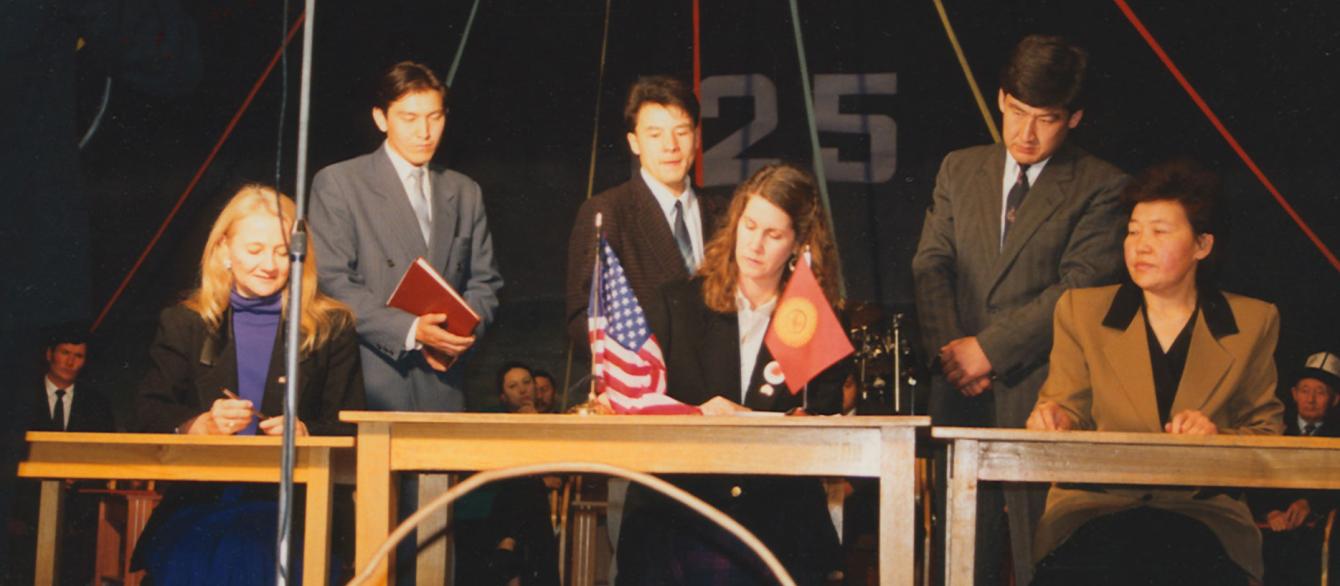
A 1994 ceremony in Karakol, Kyrgyzstan, to sign a USAID assistance agreement with the mayor. The deputy USAID director from Almaty is on the left and the mayor of Karakol is on the right.
Over the course of three years we initiated programs, managed by the U.S. Agency for International Development (USAID), to privatize residual Soviet enterprises and train Kyrgyz citizens in basic skills such as accounting, English language, information technology, health care delivery, and rule-of-law judicial processes. We lobbied Washington, and the U.S. Department of Agriculture in particular, to donate surplus food such as wheat and cooking oil to Kyrgyzstan.
When UNICEF came to me to say that children across the country were failing to get sufficient nutrients in their diets, we worked with them and Mercy Corps, a U.S. nongovernmental organization, to establish Kyrgyzstan’s first-ever flour fortification process. Mercy Corps provided the equipment for the mills and the supply of powdered vitamins to be added to the flour; UNICEF paid to bring in technicians to train the mill operators in the process and also signed agreements with the mills to prevent them charging more for the fortified flour; and the U.S. government provided air transportation from the United States to Kyrgyzstan for the milling equipment and supplies.
We were able to convince the Montana Air National Guard, which had been paired with Kyrgyzstan under a sister-state relationship by the U.S. Department of Defense, that now was a great time to make a practice run to Bishkek, and by the way, could we load a shipment on board their empty plane? After this successful operation, UNICEF no longer had to import children’s vitamins and try to get them into the hands of families across the country, as children now would receive vitamins in their daily bread.
As a side note, the Montana Air Guard was our fallback choice for transportation. Earlier we had contacted the Barnum Bailey Circus headquarters to ask for their help. They were sending a transport plane to Kyrgyzstan to pick up a Kyrgyz acrobatic horseback group and their horses that would be performing in the circus. The Barnum Bailey folks were actually quite happy to load the U.S.-made mill equipment and supplies of vitamin supplements onto their empty incoming plane, but unfortunately the equipment was not ready in time for their flight.
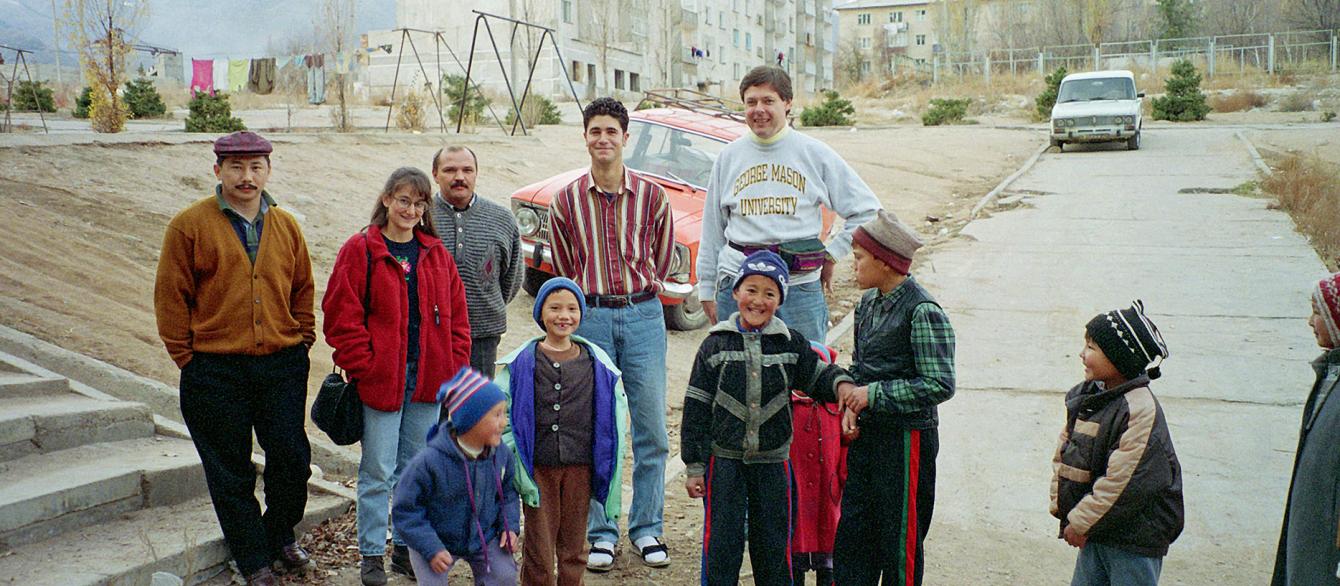
A photo taken during a visit to a Peace Corps volunteer.
By the second year, we were supporting a successful microcredit program that enabled small farmers and entrepreneurs to establish or expand their businesses. The majority of the loan recipients were women with repayment rates over ninety percent. While in Washington for consultations, I traveled down to Georgia to explore possible assistance in Kyrgyzstan by the Carter Center and Habitat for Humanity. Habitat was very interested, and later that year sent an expatriate advisor to Kyrgyzstan to set up a Habitat for Humanity organization—their first in the former Soviet Union.
President Askar Akayev was very supportive of our efforts to get Habitat up and running, as land disputes—especially disputes over land with access to water—and a shortage of housing were creating urban and rural tensions. But even more, he was interested in having a big ceremony to open the planned new Habitat housing in the hope that former President Jimmy Carter would participate.
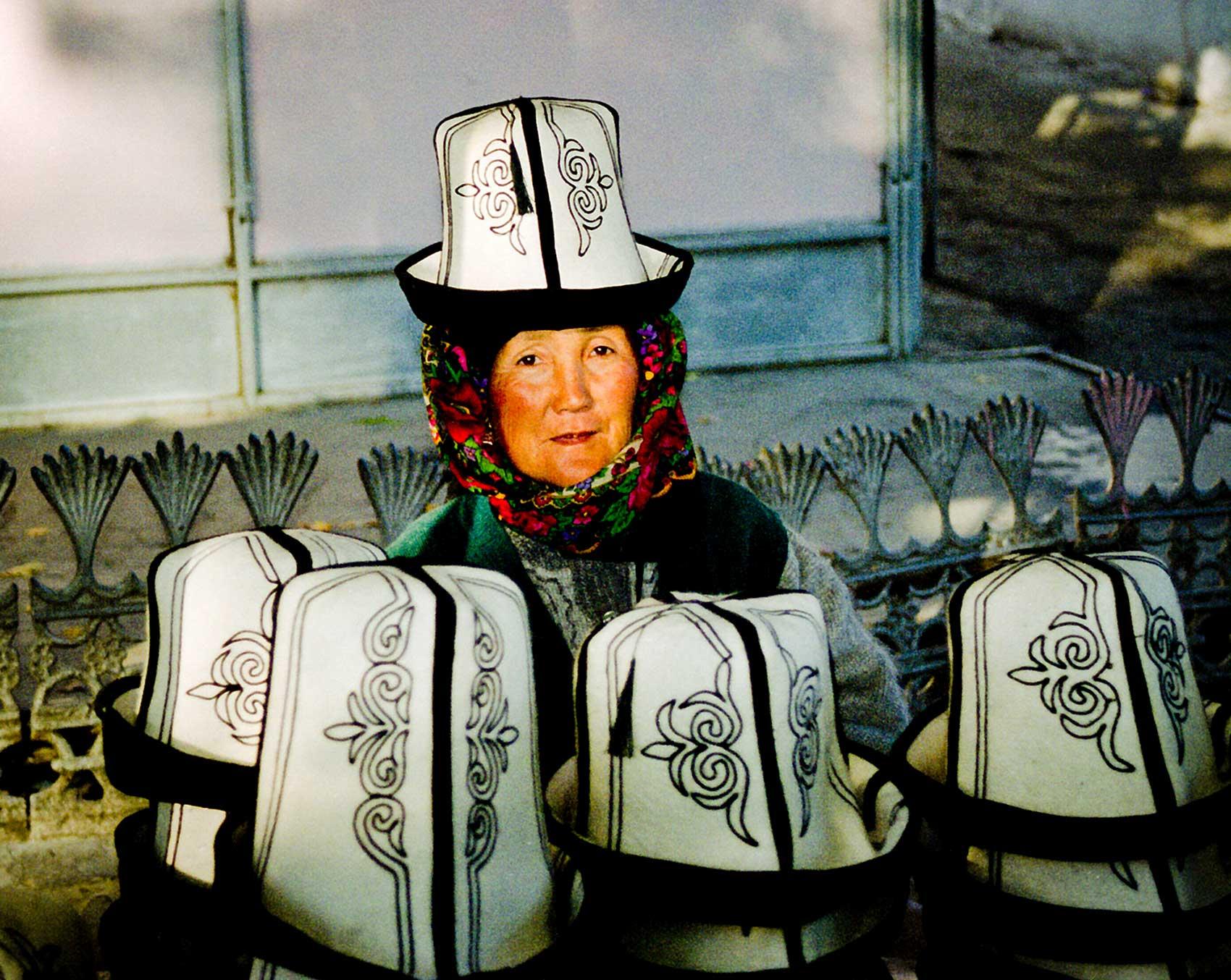
A microcredit loan recipient with the hats she was selling.
All of our economic assistance programs were operated with the best of intentions, but not all were as efficient or productive as we had hoped. The majority of U.S. funds were spent on salaries and expenses for U.S. contractors. President Akayev complained to me that his people were demanding to see how the more than $50 million provided annually by the United States to Kyrgyzstan had been spent, and all he could see was a flock of American contractors being paid large salaries.
Within the U.S. government there were occasional disagreements over the approach taken to bring about change. Once, USAID, which was based in Kazakhstan, asked me to deny country clearance to one of their own U.S. contractors. Their rationale was that the contractor was not meeting expectations, and they wanted to sort that out before allowing him to resume his work in Bishkek. So, our embassy sent a cable to Washington denying the contractor permission to enter Kyrgyzstan on official U.S. business.
Shortly thereafter John Bolton came bursting into my office in full Yosemite Sam mode, pounding on my desk and demanding to know why I had denied him, John Bolton, country clearance. He asked if I knew who he was. I told him that I had not denied him country clearance, and did not even know he was planning to visit Bishkek, but the contractor he was representing (at that time he was not in government but rather working as a lawyer) was having problems with USAID Almaty, and I suggested that perhaps they return there to sort them out.
Understanding Kyrgyz culture and politics was like peeling an onion. Each time you thought you understood what was happening, you would find your assumptions had been based on an outer layer, not the core.
I had first visited Central Asia in 1981, having received permission from the Soviets to make stops in Uzbekistan and Kazakhstan. The next time I visited was when I was sent by Embassy Moscow to witness the destruction of Intermediate-Range Nuclear Forces (INF) missiles at the Soviet missile elimination site in Kazakhstan. While I had more experience in Central Asia than most U.S. Foreign Service officers when I was confirmed by the U.S. Senate as Ambassador to Bishkek, what I knew was Soviet culture and Soviet practices in Central Asia. None of my previous experiences—aside from helpful information gleaned from an ethnic Kazakh living in Moscow, and from reading Murray Feshbach’s excellent works—prepared me for my three-year tutorial on Central Asian culture, Kyrgyz politics, and Kyrgyz history.
Friends for Life
Understanding Kyrgyz culture and politics was an activity akin to peeling an onion. Each time you thought you understood what was happening, who was supporting who, why the government made the decisions and took the actions it did, you would find your assumptions had been based on an outer layer, not the core.
Masters of hospitality, Kyrgyz people are gracious and amiable hosts. They would never say no to a guest, and we were guests in their country. I had a steady stream of U.S. government visitors and American business people call on me to exchange views and describe their proposed programs or projects. As they were telling me that they had received Kyrgyz government permission to do X, Y, or Z, I would ask them one key question: Did the Kyrgyz official say “Yes, I hear you,” or “Yes, I agree that your project/program can go forward?” In virtually all cases, the answer was simply that the Kyrgyz official had nodded and said, “Yes.” In Kyrgyzstan, “Yes” can mean “Yes,” or it can mean, “You are my guest and I would never insult you by saying no directly.”
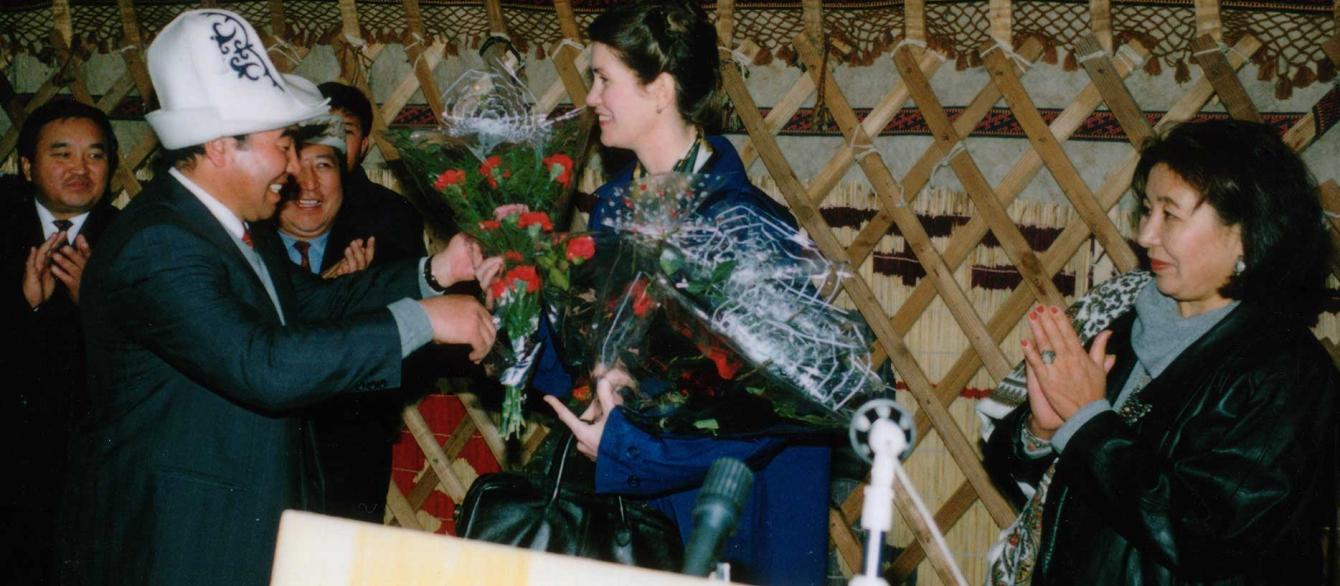
Malloy receives an award from President Akayev.
Kyrgyz culture to a large extent is based on traditional nomadic life. The Soviets had built an opera house in Bishkek where one could listen to opera or watch a ballet, but that was Russian or Soviet culture, not Kyrgyz. Clans, horses, traditional yurt life, traditional music, and shamanism were the foundations of Kyrgyz culture.
Being a successful diplomat required immersion in this lifestyle, to include five- to six-hour-long dinners where horse ribs and grilled sheep’s head were served, and lots and lots of alcohol was consumed. Kyrgyz tradition holds that only visitors who share a meal are trustworthy. The usual Washington lightning visit would receive nothing more than polite smiles from the Kyrgyz. Staying longer, sharing meals and small talk, conveyed respect for the dignity of the host. Only then could business be discussed.
The biggest problem, however, was learning how to handle the toasting rituals. In Kyrgyzstan you drink from your glass only when a toast has been made, and then you are expected to drain the glass. The Kyrgyz pride themselves on their oratory to include poetry, so toasts were competitive and frequent. Each person at the table was expected to offer a toast, so whenever I entered a room with 15 to 20 places set at the table, I knew I was in trouble. Fortunately, my Kyrgyz friends gave me hints on how to survive the toasting process without going into an alcoholic coma. My junior officers and Washington visitors, however, occasionally struggled to emerge from these events walking in a straight line.
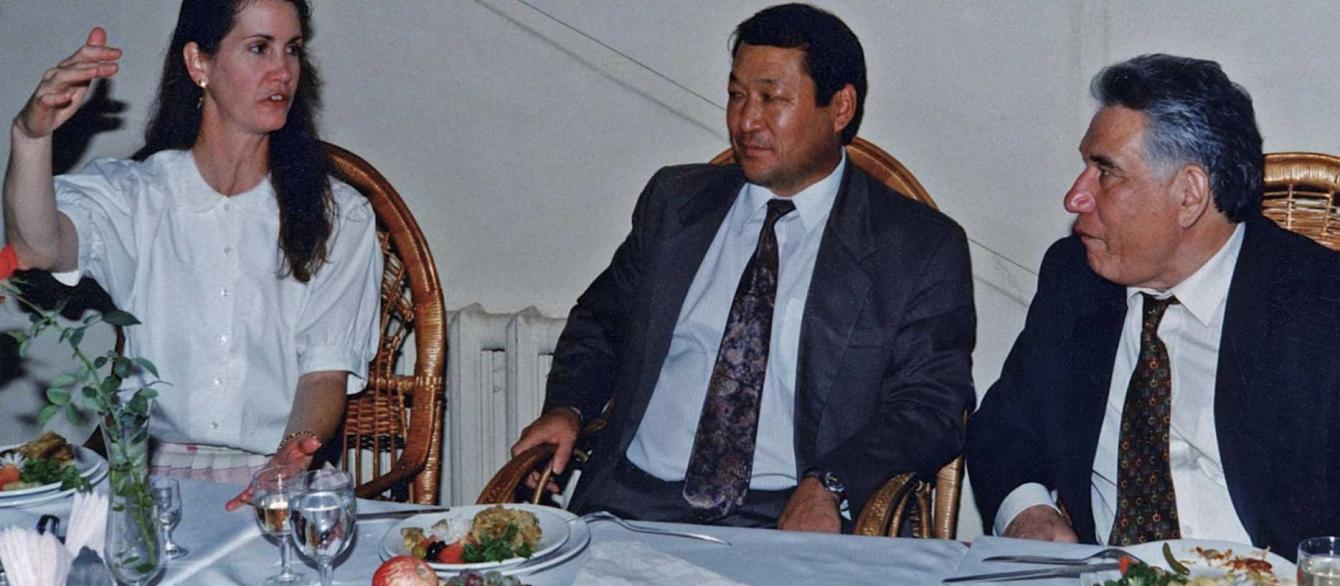
A luncheon in Bishkek with Chingiz Aitmatov.
Another aspect of Kyrgyz culture is that once you have completed the ritual above, you are friends for life. And friends do anything for their friends. I had to limit my participation in such bonding events, as I quickly became inundated by requests (demands) from my new “friends” for everything from U.S. visas to the transportation of prohibited items. Even after three years I was not able to convince high-level Kyrgyzstanis that U.S. laws and rules applied to everyone in the United States, including a U.S. ambassador. I could give them dignity, but I could not arrange to transport fresh horse meat to the president’s son, who was in residence at the University of Maryland.
I did, however, agree to go on a three-day trip through the mountains of Jalalabad with Mrs. Akayeva (the president’s wife), my young daughter, and Mrs. Akayeva’s son. I thought we would be hiking but instead found myself riding a Kyrgyz pony, sitting on a traditional wooden saddle, and clopping up a steep mountain stream bed to reach the high pasture land. We spent nights in a yurt, ate outdoors, and enjoyed the breath-taking scenery all while talking about the need to end bride kidnapping, the possibility of whether the Kyrgyz would allow international adoptions, and the best ways to meet the needs of the Kyrgyz people.
On the third day of summer heat, the security guards keeping a watchful eye on the president’s wife dropped us at an alpine lake and withdrew in a boat. On several previous occasions Mrs. Akayeva had invited me to accompany her on a midnight skinny dipping foray, but I had demurred. Turns out it was now swimming time, but I did not have a swimsuit.
The other ladies got into the water and I was left on shore…until I decided it was time to go skinny dipping for my country. Just as I swam out to them, I realized that the water was freezing cold—it was snow melt—and I decided to get out. Mrs. Akayeva calmly told me that this would not be a good idea, and pointed to the boatload of security officers coming around the corner to check on us. It took ten or fifteen minutes for her to wave them off before I could return to shore and dress.
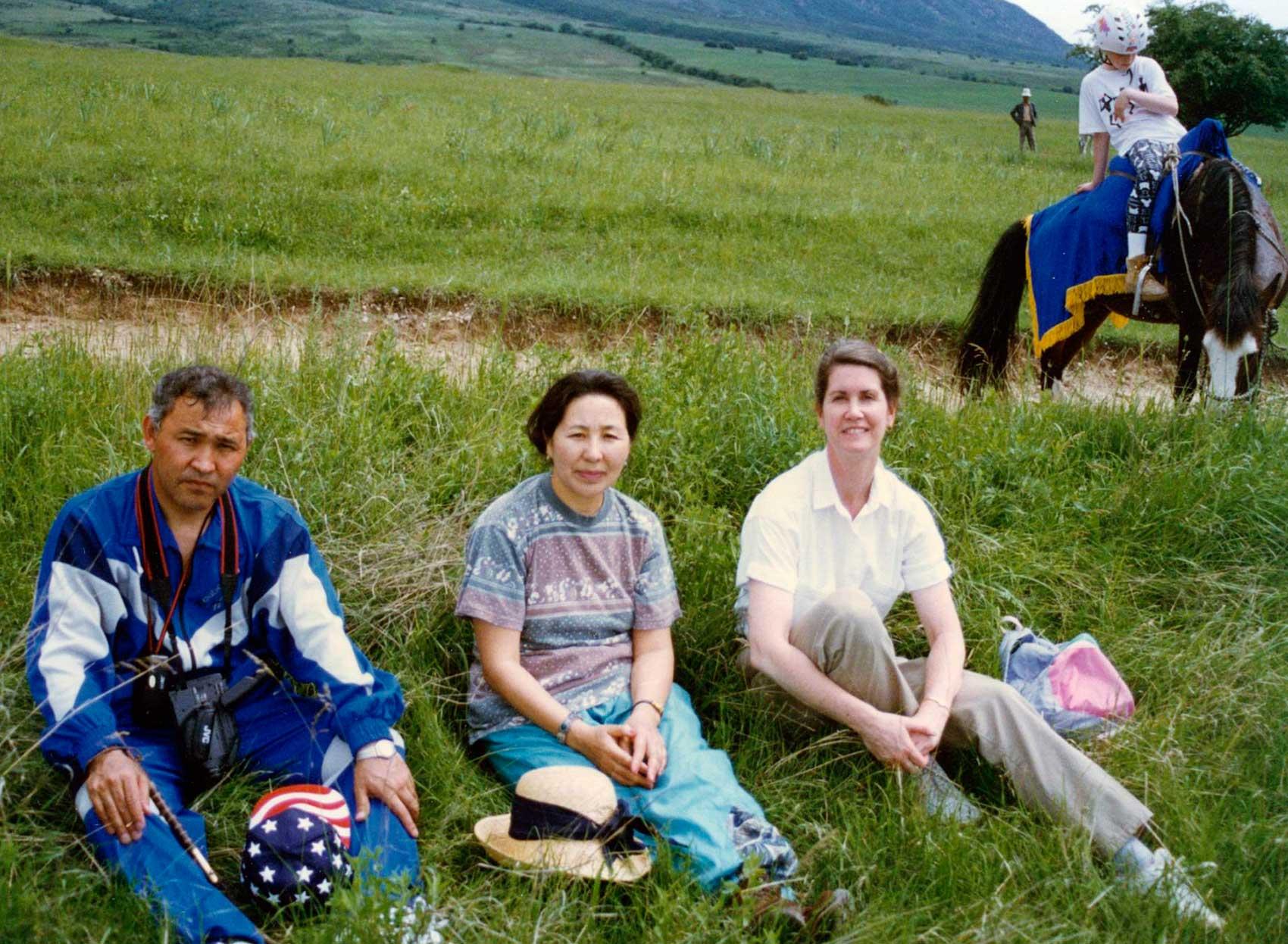
Malloy and her daughter (on horse) on a horseback trek with Mrs. Akayeva.
Illiberal Democracy
President Akayev and his wife were beneficiaries of the Soviet educational system. Highly educated, both held Ph.D.s and lived a privileged life during and after the Soviet Union. Akayev sincerely wanted the Russian-speaking citizens of Kyrgyzstan to stay and help build the new country. He insisted that Kyrgyzstan have two official languages—Kyrgyz and Russian—to signal his openness to an ethnically mixed country.
That said, once I got closer to him and he seemed to trust me a bit more, he was frank about the suffering Kyrgyz people had endured at the hands of the Soviets. While Moscow was no longer officially in charge of Kyrgyzstan, he resented the heavy-handed approach Moscow used to force him to agree to steps that were more in Russia’s interests than those of Kyrgyzstan.
That year, the final resting place of a large number of Kyrgyz intellectuals, nationalists, and writers who had been arrested by the KGB during the dark days of the 1930s was uncovered. Akayev and Chingiz Aitmatov, whose father was executed in 1938 and then buried in this mass grave, established a cemetery and a monument at the Ata Beyit site so that the Kyrgyz would never forget what had been done to these people. Aitmatov was buried at this cemetery in 2008. Akayev was particularly incensed by what the Soviets had done to his father. Arrested by the KGB, his father was imprisoned in a forced labor camp. By the time he was released years later, he had gone blind. It was Akayev’s job as a child to guide his blind father. He likened his work as president to his assistance to his father—he was guiding the Kyrgyz people to the future.
President Akayev often told visitors that he wanted to create a democratic system of government in Kyrgyzstan. What was clear to me, however, was that he had only the thinnest level of understanding of what that meant. For example, when the Russian Orthodox Church in Moscow became unhappy with the inroads made by evangelical churches in the former Soviet Union, the Patriarch of the Russian Orthodox Church began to press these new countries to enact restrictions on these religious groups. He visited Kyrgyzstan and predictably, not long after his departure, the Kyrgyz government put out a series of broad new restrictions on “sects” seeking to convert Kyrgyz away from Islam.
I called on Akayev to discuss this, using my usual approach of telling him the impact of his decision, rather than telling him the decision was right or wrong. I asked him about the focus these new restrictions were taking on the Baptists, and explained that in the United States, the Baptists were not considered to be a dangerous “sect,” nor were the Mormons. When he was less than impressed by this factoid, I asked him to name the religion of then-President Bill Clinton. He did not know, so I told him, “Baptist.” I asked what was the religion of former President Jimmy Carter, whom he hoped to attract to a visit to Kyrgyzstan. He did not know, so I told him, “Baptist.” I then asked him what my religion was. He replied, “So now you are going to tell me that you too are a Baptist!” But I responded that actually I was Roman Catholic, but had attended a Baptist church for several years. Fortunately, the most severe restrictions on evangelical churches were not implemented, but religious freedoms were still at risk.
I asked the president to tell me why he had committed to freedom of religion in the new Kyrgyz republic if he did not plan to support this freedom. He explained that to Kyrgyz people, freedom of religion meant an ethnic Kyrgyz could freely practice Islam, an ethnic German could practice Catholicism, and the Russians were free to practice Orthodoxy, but, in his words, the Kyrgyz people would never accept an ethnic Kyrgyz adopting a religion other than Islam. He suggested that such converts likely would be driven out of their communities, or worse. The new restrictions, he claimed, were to protect Kyrgyz from such violence. Kyrgyzstan was a perfect example of the “illiberal democracy” so eloquently described by Fareed Zakaria.
For official Washington there were two faces representing Kyrgyzstan—President Akayev, and the first Kyrgyz ambassador to the United States, Roza Otunbayeva. Roza was a remarkably quick study in the complexities of Washington’s assistance network. Desk officers from the Departments of Agriculture, Commerce, State, and even the Pentagon would find themselves captivated by her pleas for support for this emerging democracy.
In my second year, President Akayev brought Roza back to Bishkek to serve as his foreign minister. The two of them never saw eye to eye on domestic politics, but they did agree on major foreign policy goals, to include managing the Kyrgyz–United States relationship and the Kyrgyz-China relationship. I suspect the president saw her as a competitor and a threat to internal harmony, as she lobbied within Kyrgyzstan to end such traditional practices as bride kidnapping. I regarded Roza as the “canary in the mine,” so when she left Akayev’s administration, it was clear that internal corruption was a serious problem.
By my third year the president was supporting onerous civil prosecutions against journalists who were critical of his administration, and after initially welcoming the Soros Foundation’s educational assistance programs, he was now trying to push the resident director out of the country. Signs of corruption, especially related to the distribution of energy, were reaching disturbing levels.
I worried that then–Vice President Al Gore’s close rapport with Akayev, based on Akayev’s public persona as a champion of democracy, could put Gore at risk. We drafted our “tough love” cable proposing that the United States government tie our substantial assistance directly to Kyrgyz government political actions. The cable received mixed reactions from Washington, but it did flag the political backsliding for Washington senior officials.
My last interaction with President Akayev was to accompany him on a visit to Washington, where he had a meeting with Al Gore in the White House. The two men were quite friendly with one another, but there was a noticeable strain in the room. Akayev, unhappy that White House schedulers had not arranged for him to meet with President Clinton, kept glancing at the door, hoping in vain that the president would swing by for a quick handshake and photo op.
Speaking in Russian, he asked Gore to support a Kyrgyz proposal that the United Nations designate 1998 as “The Year of Gore.” As soon as those words came out of the State Department interpreter’s mouth, there was an audible gasp from all of us who spoke both English and Russian, and a perplexed expression on Gore’s face. What Akayev had actually asked was Gore’s support for a proposal to designate 1998 the “Year of the Mountain.” The Russian word for mountain is pronounced gore, hence the snafu. The interpreter immediately corrected the mistake, prompting Gore to laugh and tell Akayev that, actually, he had preferred the first translation. That eased the tension a bit, but it was clear to Akayev that the honeymoon was over.
We used to like to say that Bishkek was not the end of the world—but that you could see it from there.
Water is a key commodity in Central Asia. Kyrgyzstan, bisected by its high mountains, was the watershed not only for its own citizens, but also for their much more powerful Uzbek neighbors downstream. Within Kyrgyzstan there were allegations that land with access to water was distributed to ethnic Kyrgyz, leaving ethnic Uzbek citizens of Kyrgyzstan with dry land, and vice versa. To add to the volatile mix, refugees from Tajikistan’s violent conflicts crossed into southern Kyrgyzstan. When violence broke out in the Fergana Valley region of southern Kyrgyzstan, it was almost always connected to water shortages.
In one instance the UN High Commissioner for Refugees (UNHCR) representative in Bishkek came to me to discuss recent attacks by Kyrgyz villagers on Tajik refugees housed in southern Kyrgyzstan. Turns out that when UNHCR helped establish the camp, they did what is normal for refugee camps—they piped in running water. Nothing grand, but essential to sustain the families living in the camp. The problem was that the water system crossed near Kyrgyz villages that lacked access to running water, thus generating resentment of the refugees. The answer was to give the villages access to the water system.
The Uzbek government put tremendous pressure on the Kyrgyz government to allow snowmelt from the Tien Shan mountains to flow freely into the Fergana Valley’s river system and across the border. The Uzbeks are the farmers of Central Asia while the Kyrgyz are the nomadic sheep herders. Kyrgyzstan ended up with the short straw in terms of Central Asian energy resources. The Kazakhs and the Turkmen were winners, Uzbekistan had some access to energy resources (though not on the scale of Kazakhstan), but Kyrgyzstan ended up with very little except for potential hydropower. The Soviets had built a few hydropower dams in Kyrgyzstan, and had mapped out future dams, but any move by the Kyrgyz to attract international donors to construct these projects ran into Uzbek roadblocks. The Uzbeks played hardball on this one, even going so far as to turn off the gas supplies to Kyrgyzstan in the midst of a bitter cold winter to make their point.
Relations with China were fairly smooth on the surface, but the Kyrgyz people were frightened of their neighbor’s huge population, fearing that intermarriage would eventually allow the Chinese to populate Kyrgyzstan’s vast empty spaces. The Chinese nuclear testing site just over the border was blamed for widespread environmental damage in Kyrgyzstan. Cheap Chinese goods flooded the Kyrgyz market hurting local production, and many Kyrgyz were concerned about their fellow ethnic Kyrgyz living in China’s western regions. The Uighur population in Bishkek was most concerned about Chinese law enforcement officers crossing into Kyrgyzstan to repatriate Uighurs who had escaped from China. While the Kyrgyz government denied to us that they were allowing Chinese officials to forcibly return Uighurs to China, we believed that this was happening.
Earthquakes and Embassies
The embassy that served as our base of operations for diplomatic work in Kyrgyzstan was housed in a small log building that had been a dental clinic in its previous life. It was one large, open room with a small side office for the ambassador. No kitchen, one bathroom for 50 plus staff members (soon to rise to 70 when we hired a guard force), wiring strung underfoot and overhead to support lights and computers, the chancery looked more like a military Quonset hut than an embassy.
There was no setback from public sidewalks and roads, people walking by could knock on my office window and wave at me, no fences, no guard force, and worse of all—no protection from earthquakes. Central Asia is off the scale in terms of potential earthquake damage. Virtually the entire city of Tashkent, Uzbekistan, was leveled by an earthquake during the Soviet period. I was determined to start the process of building a chancery where our staff could work in safety. Funding, as always, was the problem.

The ambassador’s office in 1994 with the window that the public could use to peek into the office.
It is said that when the State Department agreed to open embassies in each of the new countries of the former Soviet Union, they did not lobby Congress for the funds needed for construction and outfitting of these new buildings. Most often the State Department found existing Soviet-era buildings and cobbled together a workable space. In Bishkek that was not possible, as virtually every building in the city failed to meet standards for seismic protection. U.S. engineers visited our log cabin chancery and showed me a diagram detailing exactly how the building would collapse inward during an earthquake, and how the staff members would be crushed.
On my next visit to Washington I called on Pat Kennedy, who was in charge of the part of State responsible for building embassies around the world. I had heard that a legacy chancery building in Western Europe was being sold, and the proceeds would be used to refurbish an ambassador’s residence in that region. I asked Pat to redirect part of those funds to building a small chancery in Bishkek, but he made clear that would not be possible. Meetings such as this one would be recorded by a notetaker and made part of State’s internal records.
I told Pat that the notes of our meeting, and my personal notes, would record the fact that we had met that day to discuss the critical need for a safe workspace in Bishkek. It would take about eighteen months to construct a chancery, so if there was an earthquake in that eighteen-month period, he was off the hook. If there was an earthquake after eighteen months from the day of our meeting, the meeting notes would have to be shared with the internal review board charged with examining the loss of life. Pat, who went on to be a superb Under Secretary for Management at State, subsequently told me that he often told the story of how he had to spend an unbudgeted $15 million to construct a chancery in Bishkek. Roza Otunbayeva and I performed the groundbreaking ceremony for the new U.S. Embassy in 1997, and our embassy staff moved into the new chancery in 1998.
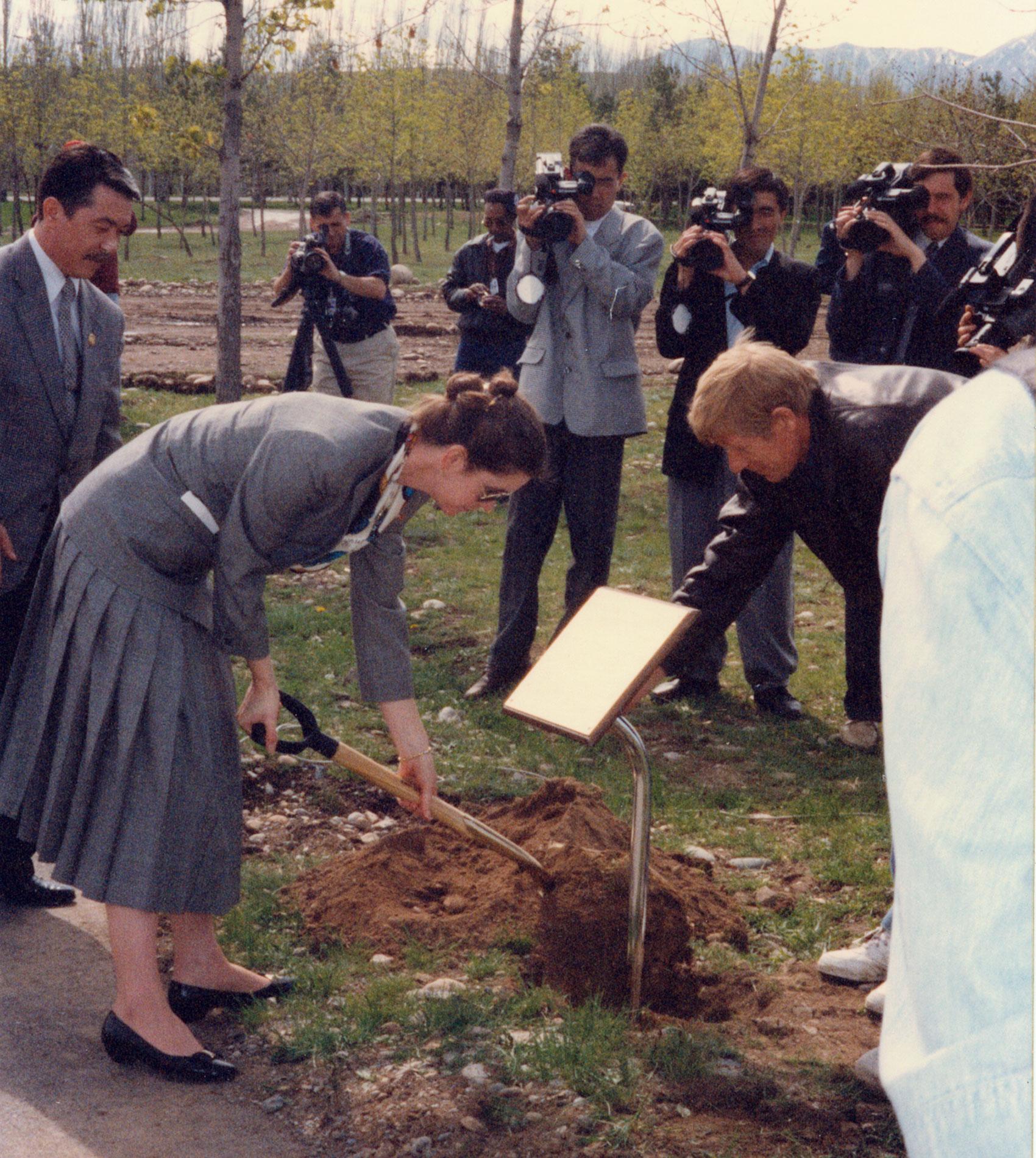
The groundbreaking ceremony for the new chancery in Bishkek.
Earthquakes were not only dangers in Kyrgyzstan. Car accidents were common, especially at night when Kyrgyz drivers followed the bizarre Soviet practice of not using headlights—they believed that headlights blinded oncoming drivers. Drinking and driving was a huge problem, and horses and livestock were frequently loose on the roads.
The complete lack of emergency medical care was brought home when one of my American staff members suffered a massive stroke. Even with our best efforts—including performing CPR in shifts for more than 12 hours, as the hospital had no oxygen in its tanks—there was no medication to help him, and with the medical evacuation flight having taken 18 hours to land in Bishkek, he died. Ours was a very small American community, and we were crushed by our inability to save his life.
After that loss, we negotiated with the local hospital to set up a locked cabinet to house equipment and supplies needed to support emergency medical care. That way we knew we could handle a serious car accident or major illness.
We also realized that our ability to repatriate a deceased American was woefully inadequate, as there were no embalming facilities in the country. Later, when a helicopter leased by a Canadian gold mining operation crashed, killing all seven expatriates on board, my first reaction was sadness, then sympathy for the Canadian embassy in Moscow, and then the realization that as there was no Canadian embassy in Kyrgyzstan, we would have to recover and repatriate the bodies of the deceased Canadians.
My staff members carried out this sad duty using whatever means they could find. Months later I found out how they had done it when I received a chiding cable from the diplomatic mail service at State complaining that we had destroyed a number of huge diplomatic mail pouches. I doubt the mail handlers really would have appreciated it if we returned to them pouches that had been dragged up the side of a mountain and filled with human remains, so I just apologized and promised we would not be so careless in the future.
We used to like to say that Bishkek was not the end of the world—but that you could see it from there. The mid-1990s predated widespread use of the Internet, leaving Kyrgyzstan in an information void. With the assistance of the United States, the Kyrgyz created what is now the most active NGO space in Central Asia. Even after the government walked back their commitment to freedom of the press, Kyrgyz NGOs found ways to alert their fellow citizens, and the world, to corruption and abuse of citizen rights. The United States left the people of Kyrgyzstan an enduring gift—a voice for Kyrgyz NGOs to press for an expansion of democratic society and rule of law.
Eileen A. Malloy served as the Deputy Assistant Secretary of State for European and Canadian affairs in the United States Department of State. She served as the U.S. Ambassador to Kyrgyzstan from 1994 to 1997.

